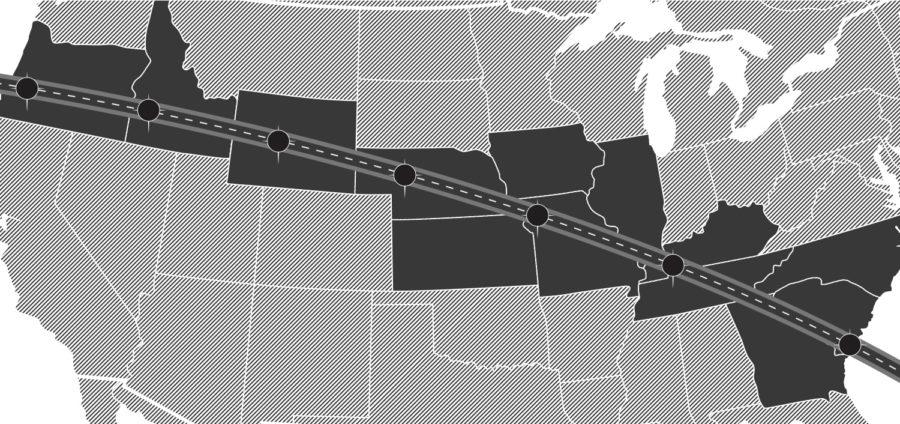Hundreds of miles for a few minutes: Iowa State community members travel to total eclipse
Design by Isaiah Johnson/Iowa State Daily
The solar eclipse will be able to be viewed in its totality in 13 states, including the very southwestern tip of Iowa.
August 16, 2017
Iowa State students spending Monday in classes could be missing out on Ames’ view of a partial solar eclipse.
But, for those reckless enough to ditch the first classes of the semester, a view of a total solar eclipse is within reach.
The path of totality, which is the area in which a total solar eclipse will be experienced displayed on a map provided by NASA, will cross the United states from Oregon to South Carolina, barely touching the southwest corner of Iowa.
That corner is an area of around 700 acres, Steve Kawaler said, an astronomy and physics professor at Iowa State.
“A total eclipse is overwhelmingly impressive. There’s just no way to describe it,” Kawaler said.
This solar eclipse will be Kawaler’s fourth total eclipse.
In the Ames area the eclipse will be partial with the moon covering around 93 percent of the sun. That may seem like a lot, but Kawaler says it won’t be noticeable.
“Our eyes are very good at adapting to brightness meaning it will still look like a sunny day, even though it’s such a small sliver of the sun,” Kawaler said. “It is still so bright.”
Totality will be experienced in larger portions of Iowa’s neighbors, Nebraska and Missouri, including Columbia, Missouri, where Kawaler is traveling with his family to experience the event.
Galaxy collisions graduate student Travis Yeager is also among members of the Iowa State community traveling for the event. Yeager is going to the St. Louis area.
“For me, this might be the only chance I get to see a total eclipse relatively easily, so it’s definitely worth the trip,” Yeager said.
People watching the eclipse from the Ames area can expect to experience mostly the sight of the moon moving in front of the sun, without a visible darkening. However, there will be a few other effects.
“Shadows will begin to look a little weird [during the eclipse],” Kawaler said.
Kawaler suggested using a flat cheese grater to look at the round shadows and you can see how they begin to take on a crescent shape.
It is important to use eclipse glasses when watching the eclipse since staring at the sun, even while partially covered, can damage your eyes, Yeager said.
These glasses can be found at many grocery and everyday type stores, but are beginning to sell out, Kawaler said.
If you’re able to get to a place where totality is, your experience will be far different. Once totality begins, it will be nearly as dark as night.
“Assuming it’s a clear day, the stars will come out, there will be sunset colors all around the horizon,” Kawaler said.
Kawaler added that Venus, Mercury and Jupiter should each be visible as well. The partial eclipse will begin around 11:30 a.m., said Yeager, and totality begins around 1 p.m.
If you are experiencing totality, you can expect day to turn to night for 2 ½ minutes which is the amount of time the moon will completely cover the sun.
Ryan Maguire is a freshman at Iowa State in materials engineering who is sacrificing his first day of classes at Iowa State to travel to St. Joseph, Missouri to see the total eclipse.
“This is an opportunity that will only come around a few times in my life,” Maguire said. “Just being close to totality isn’t close enough. I want to see it,”
From freshman students to professors, the draw is the same: the thrill of the eclipse.
“There isn’t much scientists can take away from eclipses anymore that can’t be learned from space, so most just watch it to enjoy it,” Kawaler said.
Reiman Gardens will be holding an event to view the eclipse from 11 a.m. to 3 p.m.
Kawaler and Yeager both agreed that while the partial eclipse is interesting, a total eclipse can’t be missed.
“Talking to your friends who went to see totality is probably the best thing you can look forward to if you only see the partial eclipse,” Kawaler said.







